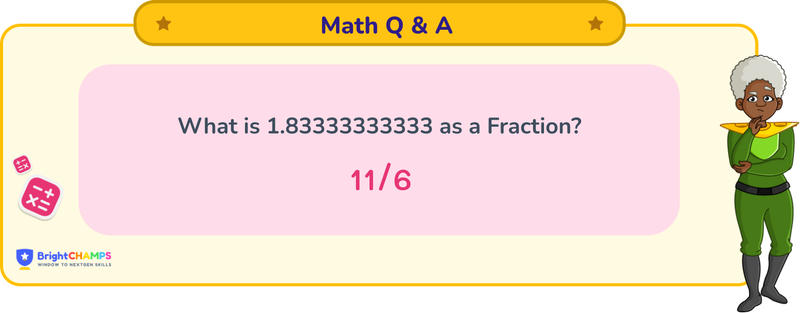Summarize this article:
 232 Learners
232 LearnersLast updated on August 5, 2025
1.83333333333 as a Fraction

Numbers can be categorized into different types. Fraction is one of its kind. It is always represented in the form of p/q, where p is the numerator and q is the denominator. Fractions represent a whole and a fractional part. Decimals represent the fractional part of numbers. For example, 1/2, the numbers in decimal are expressed with a decimal point (.), For example, 1.83333333333, we are going to learn how to convert a decimal to a fraction.

What is 1.83333333333 as a Fraction?

Answer
The answer for 1.83333333333 as a fraction is 11/6.
Explanation
Converting a decimal to a fraction is a task for students that can be done easily. You can follow the steps mentioned below to find the answer.
Step 1: Firstly, separate the whole number part from the decimal part. Here, 1 is the whole number, and 0.83333333333 is the decimal part.
Step 2: Recognize that 0.83333333333 is a repeating decimal, specifically 0.8(3). To convert this repeating decimal to a fraction, let x = 0.8(3).
Step 3: Multiply x by 10 to shift the decimal point: 10x = 8.333333...
Step 4: Multiply x by 100 to shift the repeating part: 100x = 83.333333...
Step 5: Subtract the first equation from the second: 100x - 10x = 83.333333... - 8.333333... 90x = 75
Step 6: Solving for x gives: x = 75/90 Simplify the fraction using the GCD of 75 and 90, which is 15: x = 5/6
Step 7: Combine the whole number with the fraction: 1 + 5/6 = 11/6
Thus, 1.83333333333 can be written as a fraction 11/6.

Important Glossaries for 1.83333333333 as a Fraction
- Fraction: A numerical quantity that is not a whole number, representing a part of a whole.
- Decimal: A number that uses the base ten and includes a decimal point to separate the whole part from the fractional part.
- Numerator: The top part of a fraction, indicating how many parts of the whole are being considered.
- Denominator: The bottom part of a fraction, showing how many parts make up a whole.
- Repeating Decimal: A decimal that has one or more repeating digits or sequence of digits after the decimal point.





